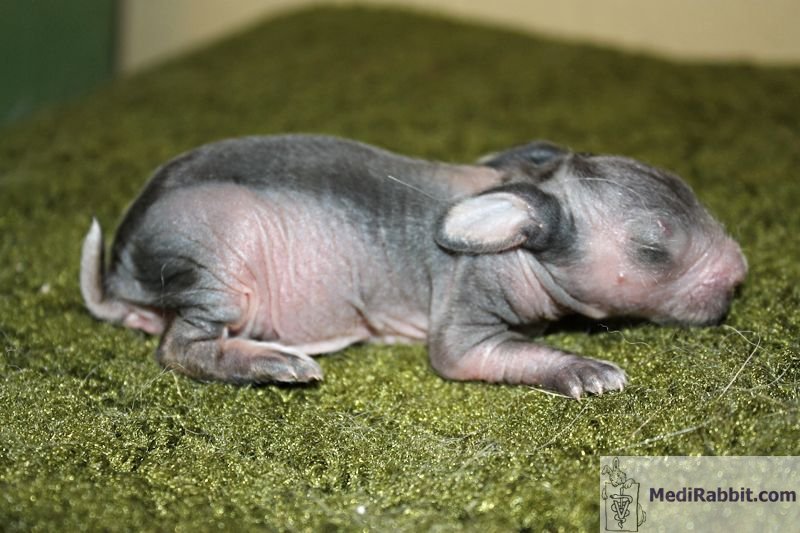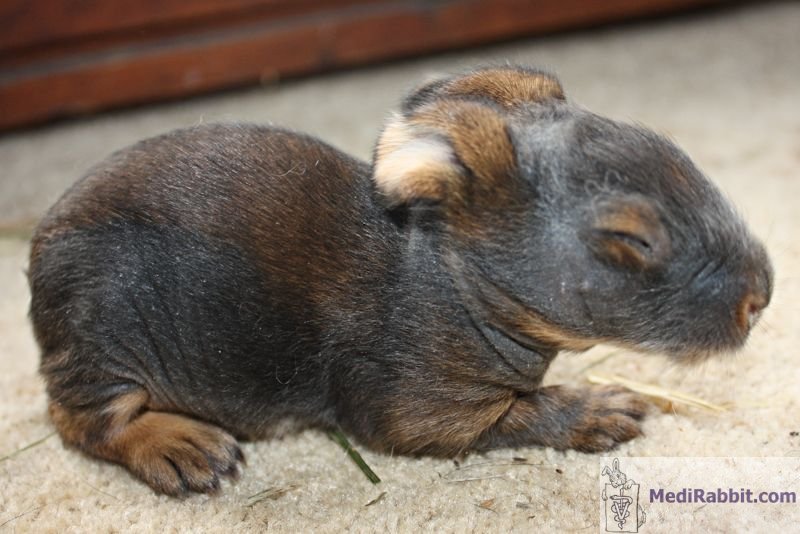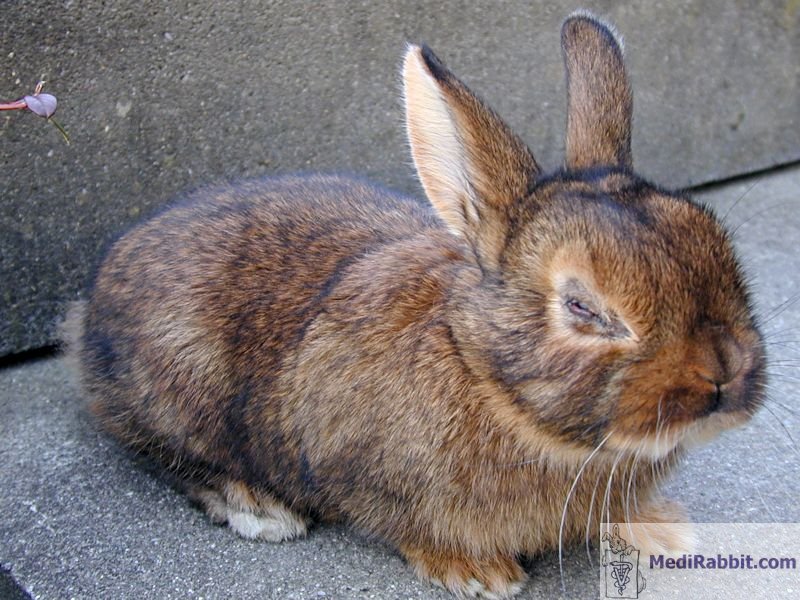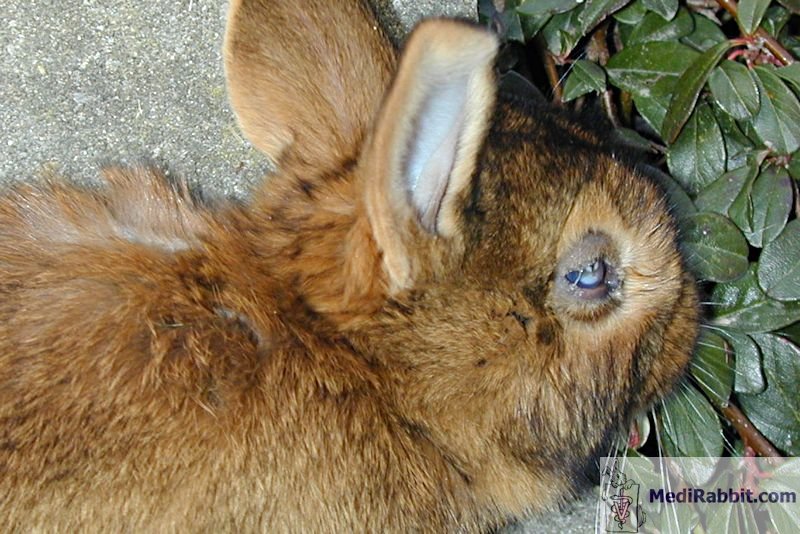“Nest box eyelids” in young rabbits and winter
temperatures
Esther van Praag, Ph.D.
MediRabbit.com is funded solely by the
generosity of donors.
Every donation, no matter what
the size, is appreciated and will aid in the continuing research of medical care
and health of rabbits.
Thank you
|
|
Around 10-12 days, eyelids of newborn rabbits separate
and the young can finally discover their environment. It happens, however,
that eyelids remain shut. Causes and how to fix this problem?
Michel Gruaz
A newborn rabbit is born with closed
eyelids The opening of eyelids takes place between the 10th and
the 12th day after birth. A small split appears,
which progresses from the outer cutaneous face of the eyelid to the
conjunctival inner surface. The ligaments and muscles of the eyelids also
participate in the opening of the split. Once the eyelids get separated, their
free edges gradually harden, eyelashes appear and the sebaceous glands,
located on the inner edge of the eyelids, become functional and release
secretions that will lubricate the eyelids.
Michel Gruaz
At 9 days, the eyelid of this young
Belgian bearded rabbit show a first sign of opening in the corner of the eye Nest box eyelids typically affect
one or two individuals per nest, sometimes more. This problem has been little
studied in rabbits. One breeder found that litters of some rabbits were more
likely to develop nest box eyelids than other rabbits. He then exchanged the
nests between these two does. Without effect. The susceptible rabbits
continue to suffer from the syndrome, despite different care of the adopting
doe. And vice versa, the opening of eyelids of unaffected rabbits continued well
in rabbits whose kits suffer from the syndrome. He then suspected a genetic
origin to nest box eyelids. By reproducing only females with little or no
young suffering from this syndrome, the proportion of affected young could
certainly have been reduced, but not eliminated. In some nests, half of the kits
suffered from the nest box syndrome. The syndrome of nest box eyelids does
not seem to have a genetic origin. Seasonal influence
Nest box eyelids is mainly observed in nests
that are born in the winter and early spring seasons. Those born during the
summer and fall months do not suffer from this syndrome or very rarely. Why do
newborn rabbits born in summer and autumn not suffer from this syndrome? When
temperatures are high, newborn rabbits feel comfortable on the surface of the
nest. They do not migrate deep into the nest to stay warm. They have little
or no contact with dust and urine and, therefore, bacteria. When temperatures
fluctuate, newborn rabbits will migrate between the cooler surface
of the nest during the warmer day temperatures and migrate deeper in the nest
during the freezing night temperatures. Dust may settle in the split of the still
closed eyelids or under the eyelids and lead to irritation of the ocular
tissues. Mucus and tears are secreted. When these harden in the split of the eyelids,
the latter will be unable to separate and remain shut. As dust coexists with
the bacteria, the bacteria can also migrate in between the eyelids and cause
infections of the eye structures. Staphylococci and streptococci are often
responsible for these infections. Visible manifestations of such infections include
eyelids pointing outwards because of inflammation or accumulation of pus in
the eye cavity, the presence of crusts or the presence of thick yellowish pus
between the eyelids.
Michel Gruaz
The presence of pus between the eyelids
must be taken seriously in rabbit kits as bacteria can invade the cornea and
lead to the latter to become bluish. Hygiene
and heating lamp It is impossible to eliminate all
bacteria and other microorganisms of a rabbit nest. A very good hygiene makes
it, however, possible to keep these intruders under control. Hygiene of the
nest is therefore very important. After the birth of the young, the remains
of placenta and stillbirths of the nest must be removed. Soiled litter is
replaced by fresh, non-dusty litter: straw, hay or wood chips without
sawdust. Cleaning of the rabbit nest should be done 2 to 3 times per week
during the cold season or when daily temperatures fluctuate. if necessary, it should be renewed entirely with clean nesting
material. If birth boxes are used, they should not be too big. This prevents that
the does stays with her kits during the day and infects the nest with her
fecal excrements and urine. It is possible to add straw or
hay to the nest built by the doe to make it deeper. A layer of wood shavings (without
sawdust) can be placed under the nest, separated from the nest by a piece of
wire. The latter acts as a physical barrier that prevents direct contact between
the newborns and the wood shavings soaked with urine and bacteria. Another
approach is to prevent migration of the newborn to the warm depths of the
nest. To this purpose, a low energy heating infrared lamp can be placed on
the side of the nest. As the warmth of the nest surface remains pleasant, migration
to nest depths is reduced. This is accompanied by a decreased risk of
developing the nest box eyelids. The electric cable must, however, be secured
with a wire mesh to prevent nibbling by the doe and must be firmly fixed to
the ceiling of the hutch to prevent fire !!! Treatment
of “nest box eyelids” It is important to check for the
appearance of a cleft or opening of the eyelids between the 10th and 12th day
of the rabbit kit. After this age, the cornea becomes opaque, with a risk
that the rabbit becomes progressively blind from the affected eye. A young rabbit is rarely the only
one of all baby rabbits in one nest. It is, thus, important to examine the
other members too. When the eyelids remains closed,
it is necessary to gently separate them. To this end, it is possible to use a
cotton swab well impregnated with a sterile saline solution, virgin coconut
oil, St. John's Wort oil or a colloidal silver solution. These all have
antibacterial properties and do not cause irritation or tingling in the eyes.
In these do not help an infusion of chamomile with a little honey or a strong
black tea can also be tried. Once moistened, the eyelids are gently separated,
starting from the corner of the eye towards the outer end. The eye is rinsed
with a sterile saline solution to remove mucus debris or other foreign
matter. Only one application is usually sufficient. If this is not the case, the
operation is repeated twice a day for a few days. In case of infection, a prompt
treatment is necessary. It is necessary to remove the infectious material at
regular intervals and to administer antiseptic eye drops. Warm compresses
placed on the eyelids prevent them from sticking together again. It is important to keep the
cornea moist, especially if the infection prevents a flutter of the eyelids. Drops
of "artificial tears" without preservatives, for human use, can be
used. If the surface of the cornea is damaged, scarring may lead to the
formation of a whitish veil. Even if it is unsightly, the adult rabbit
suffers at most from a little non-painful visual discomfort. Acknowledgement Big thanks to Michel Gruaz
(Switzerland) for his photos and his permission to use them for MediRabbit. |








